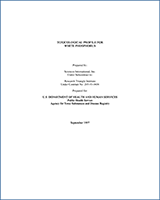NCBI Bookshelf. A service of the National Library of Medicine, National Institutes of Health.
Toxicological Profile for White Phosphorus. Atlanta (GA): Agency for Toxic Substances and Disease Registry (US); 1997 Sep.

Toxicological Profile for White Phosphorus.
Show detailsThis toxicological profile is prepared in accordance with guidelines* developed by the Agency for Toxic Substances and Disease Registry (ATSDR) and the Environmental Protection Agency (EPA). The original guidelines were published in the Federal Register on April 17, 1987. Each profile will be revised and republished as necessary.
The ATSDR toxicological profile succinctly characterizes the toxicologic and adverse health effects information for the hazardous substance described therein. Each peer-reviewed profile identifies and reviews the key literature that describes a hazardous substance's toxicologic properties. Other pertinent literature is also presented, but is described in less detail than the key studies. The profile is not intended to be an exhaustive document; however, more comprehensive sources of specialty information are referenced.
The focus of the profiles is on health and toxicologic information; therefore, each toxicological profile begins with a public health statement that describes, in nontechnical language, a substance's relevant toxicological properties. Following the public health statement is information concerning levels of significant human exposure and, where known, significant health effects. The adequacy of information to determine a substance's health effects is described in a health effects summary. Data needs that are of significance to protection of public health are identified by ATSDR and EPA.
Each profile includes the following:
- (A)
The examination, summary, and interpretation of available toxicologic information and epidemiologic evaluations on a hazardous substance to ascertain the levels of significant human exposure for the substance and the associated acute, subacute, and chronic health effects;
- (B)
A determination of whether adequate information on the health effects of each substance is available or in the process of development to determine levels of exposure that present a significant risk to human health of acute, subacute, and chronic health effects; and
- (C)
Where appropriate, identification of toxicologic testing needed to identify the types or levels of exposure that may present significant risk of adverse health effects in humans.
The principal audiences for the toxicological profiles are health professionals at the Federal, State, and local levels; interested private sector organizations and groups; and members of the public.
This profile reflects ATSDR’s assessment of all relevant toxicologic testing and information that has been peer-reviewed. Staff of the Centers for Disease Control and Prevention and other Federal scientists have also reviewed the profile. In addition, this profile has been peer-reviewed by a nongovernmental panel and was made available for public review. Final responsibility for the contents and views expressed in this toxicological profile resides with ATSDR.

Administrator
Agency for Toxic Substances and Disease Registry
Footnotes
- *
Legislative Background
The toxicological profiles are developed in response to the Superfund Amendments and Reauthorization Act (SARA) of 1986 (Public Law 99-499) which amended the Comprehensive Environmental Response, Compensation, and Liability Act of 1980 (CERCLA or Superfund). Section 211 of SARA also amended Title 10 of the U. S. Code, creating the Defense Environmental Restoration Program. Section 2704(a) of Title 10 of the U. S. Code directs the Secretary of Defense to notify the Secretary of Health and Human Services of not less than 25 of the most commonly found unregulated hazardous substances at defense facilities. Section 2704(b) of Title 10 of the U. S. Code directs the Administrator of the Agency for Toxic Substances and Disease Registry (ATSDR) to prepare a toxicological profile for each substance on the list provided by the Secretary of Defense under subsection (b).
- FOREWORD - Toxicological Profile for White PhosphorusFOREWORD - Toxicological Profile for White Phosphorus
- Trappc5 trafficking protein particle complex 5 [Mus musculus]Trappc5 trafficking protein particle complex 5 [Mus musculus]Gene ID:66682Gene
Your browsing activity is empty.
Activity recording is turned off.
See more...